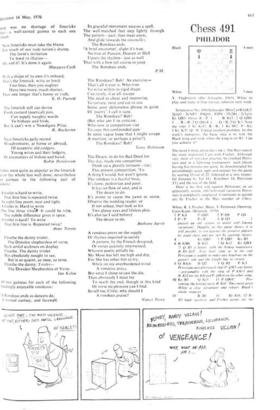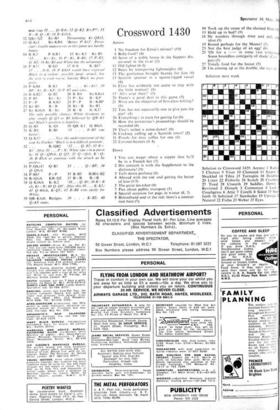Chess 491
PHILIDOR
Y. Vladimirov (Die Schwa/he, 1963). White to play and mate in four moves; solution next week.
Solution to No. 490 (Schneider 3B1n2iprR1pK2/ 2p1p3 / 2k N P3 / P4Q I b / P2P4 / 3N2B1 I 2r3q1): Kt-QB3. threat R > P. I . R- Kt3: 2 Q-QB4.
1 R x R: 2 Q-QKt4. 1 ...Q x13; 2 Q-K3. Note the tries 1 Kt Kt4?, R > R; 1 Kt B6?. P x Kt; 1 K3?, Q B. Typical modern problem. In this week's miniature. the basic idea is to fork the Black king and rook when the king is on RI Can you achieve it?
The more I think about the Lissa v. The Rest match the more impressed I am with Fischer. Although very short of top-class practice he crushed Petro- - sian and in a lightning tournament each player having five minutes per game he demonstrated his astonishingly quick sight and instinct for the game by scoring 19 out of 22. followed at a very respcc- ful distance by Tal 141. Korchnoi 14, Petrosian 131 and the rest of the field.
Here is his first win against Petrosian: in an apparently simple. old-fashioned variation Petro- sian is completely outplayed. Comments in quotes arc by Fischer in the May number of Chess.
White. R. J. Fischer. Black. T. Petrosian. Opening. Caro-Kann (Belgrade. 1970).
1 P-K4 P- QB3 2 P-Q4 P-Q4
3 PxP PxP 4 B-Q3
played an old system to avoid well - known variations'. Happily. as this game shows. if is still possible to win against the greatest players by good chess and not lust by opening theory.
4 . Kt-QB3 5 P-QB3 Kt-B3 6 B-KB4 B-Kt5 7 Q-Kt3 Kt-QR4
'7 Q-B1 is better with the bishop manoeuvre B- R4 - K 13' . Text loses time as in the end Petrosian is unable to make any headway on the queen's vide and the knight has to return.
8 Q-R4ch H-Q2 9 Q-B2 P -K3 Petrosian said afterwards that P-() R3 was better —presumably with the Idea of P-K Kti and B-Ki2 for the KB and P-()Kt4 on the other wing.
10 Kt-B3 Q- Kt3 II P-QR41 Pre- venting the freeing move B-104 'This move gives White a cleat advantage and relates Black's whole strategy' 11 . R -BI // Kt-Ktb; 12 R- R2 lead, nowhere and Fischer points out the
neat trap 11 . . . Q-K16; 12 Q-K2, B x P??; 13 R x B, Q x R; 14 B-KtSeh.
12 QKt-Q2 Kt-B3 Threatening Kt-QKt5.
13 Q-KtI Kt-KR4 'Better P-Kt3'. Petro- sian's knight manoeuvres in this game are hardly
happy.
14 B-K3 P-KR3 15 Kt-K5 Kt-B3 . . . Kt x Kt; 16 Px Kt, B-84; 17 P-R5, Q-82; 18 Kt-B3 and White has the advantage'.
16 P-R3! B-Q3 17 0-0 K-BI? /7 . , . 0-0; 18 P-KKt4 would have exposed Black to a violent-possibly fatal-attack. but the text is even worse, leaving Black no pros- pects.
18 P-KB4 B-K1 18 . . . Kt xKt?; 19 BP / Kt, B x KP; 20 P- R5 and wins.
19 B-KB2! Q-B2 20 B-R4 Kt-KKt1 21 P-B5 KtxKt 22 PxKt BxKP 23 P P B-KB3 24 PxP BxKBP 25 Kt-B3 B x B 26 Kt xB Kt-B3 27 Kt-Kt6ch Ilx,Kt 28 BxB K-K2!
The only possible chance; White threatens to play simply Q-Q3 or B5 followed by QR-KI and Black's position is hopeless.
29 Q-H5 K-QI 30 QR-K I Q-B4ch
31 K-RI R-B1 '31 . . . R-B3 was
better'.
32 Q-K5! ... Non' the understatement of the year by Fischer: 'Black is in a difficult position'.
32 . . . R-QB2 '32 . . . Q-B2; 33 R x Kt'. After 33 . . . Px R; White can win a pawn by 34 Q x QPch, Q-Q2; 35 Q x Qch, K x Q; 36 B-Bich or continue with the attack as he prefers.
33 P-QKt4! Q-B3 33 . . . QxBP; 34 Q-Q6ch.
34 P-B4 ! P x P 35 B-B5 R(B1)-B2 36 R-Qlch KR-Q2 37 BxR RxB
38 Q-Kt8ch K-K2 '38 . . . Q-81 ; 39 Rx R ch, Kt x R; 40 Q-Q6'. After this 40 . . . K-KI; 41 Q-K6ch, K-QI; 42 R-B4 wins easily for White.
39 QR-Klch Resigns. 39 . . . K-82; 40 Q-K8 mate.



































 Previous page
Previous page